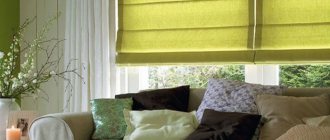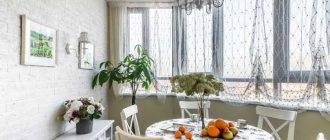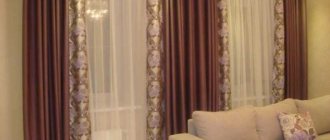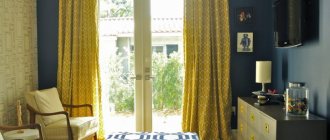Practicality, functionality and attractiveness - these are the main requirements for modern window textiles. Roman blinds are endowed with all these qualities. They have a laconic appearance and at the same time attract attention, are easy to use, easy to maintain and can be used for fabric decoration of any window openings, including arched, bay windows and triangular. Roman blinds for plastic windows are presented in a large assortment, and everyone can choose a model based on the functionality of the room and its design.
Advantages and disadvantages
Roman window models, despite their simple design, always look interesting.
They are appropriate in any interior, combine perfectly with other types of curtains and create amazing compositions, bringing comfort and harmony to the atmosphere of the room.
Other advantages:
- stylish design;
- variety of colors;
- ease of operation and maintenance;
- space saving;
- good sun protection;
- Can be used in any room;
- affordable price.
The main disadvantage is the difficult functioning of a window with a window: to open it, the panel must be lifted each time.
Living room
The room where guests gather on holidays and all family members in the evenings most often has a single block consisting of a window opening and a balcony door. This is convenient because it allows you to expand the living room space. At the same time, the design of the window and door leading to the balcony in the guest room requires a special approach. First of all, the living room should be cozy and spacious, which is quite feasible with the help of Roman blinds. Like the kitchen set, Roman blinds for the door in the photo must meet the following requirements:
- Act as an interior element that emphasizes the chosen style. You cannot choose cascading Roman blinds if the living room interior is made in high-tech style, for example. Instead, a classic version made of synthetic materials is suitable.
- Strictly comply with the dimensions of the window and door.
- Made from wear-resistant materials. For living rooms, curtains made of wicker wood or bamboo are quite acceptable. The most popular material is bamboo. It creates an amazing atmosphere of comfort and tranquility and encourages communication. It is also advisable to choose curtains made of bamboo in cases where the window and balcony block is framed by bookcases.
- The design of the curtains should not interfere with free access to the balcony.
- The fabric from which Roman blinds are made should not reduce the intensity of natural light, so that there is no need to use additional sources of artificial light.
Types of curtains
Based on their design features, there are 4 types of Roman-style lifting curtains:
- frame;
- frameless;
- cascade;
- double.
The first type is the classic option. When lifted, the canvas forms even folds due to rigid transverse strips. In the second case, there are no strips, so the formed folds sag. The third type is different in that the textile product retains its drapery even when open, because it is made with an overlap.
And the last option is two-layer models that create a “day-night” effect. One of their fabrics is dense, it serves to protect from sunlight, the other is light and airy.
You can control the raising/lowering of the canvas manually (with a cord) or automatically (with a remote control).
According to density, curtains are divided into:
- transparent, transmitting light well;
- translucent, softly scattering sunlight;
- dense, providing maximum sun protection.
Using Roman blinds in different interior design styles
Colonial style
The colonial style of interior design as such arose during the era of the Great Geographical Discoveries. It was at this time that Europeans actively conquered the world and founded more and more new colonies (hence the name of the style - colonial). As a result of this, the classic European style of interior design spread throughout the world, but began to acquire exotic features and local flavor. Since the main directions of research and geographical discoveries were aimed at the southern and eastern lands, the colonial style combines European and Middle Eastern or African features.
The colonial style is characterized by soft, pastel neutral colors. Curtains for decorating a room in a colonial style can be used only from natural fabrics in the most natural shades, but you can dilute the monotony with some exotic pattern, ornament or print.
The colonial style is not tied to a specific territory (like, for example, Provence), however, for a harmonious and consistent style, it is better to choose one theme and strictly adhere to it in order to avoid awkwardness and bad taste.
Sea style
It is difficult to imagine a style in which Roman blinds would look more appropriate than nautical ones. And this is not surprising, because the technology for making roller blinds was borrowed from sailors who assembled and straightened sails with the help of transverse cords.
In a marine style, light curtains in all shades of white, pale blue or blue would be appropriate. It is better to refrain from bright and catchy designs, especially floral motifs. On the contrary, images of shells, seagulls and sailboats, stripes would be appropriate, but they should not be flashy or provocative colors. Light cascading Roman blinds will look great.
Retro style
Retro style is perhaps one of the most interesting and unusual interior design styles, since you can find real things from that era: vintage figurines and boxes, antique furniture (instead of ultra-modern furniture from Ikea), antique mirrors. However, textile products extremely rarely retain their original appearance, so it is unlikely that you will be able to hang grandma’s curtains on plastic windows.
When planning to buy Roman blinds for a retro-style room, carefully study what fabric colors were in demand in the decade in which you are styling your interior. These can be striped, checkered or floral fabrics.
Retro is a very sophisticated and sophisticated style, so rough fabrics are not suitable for creating curtains. It would also be inappropriate to use flashy neon colors.
Minimalism
Despite the fact that textile products are used very little to decorate a room in the minimalist style, Roman blinds of the classic type will fit perfectly into this style, because they are devoid of unnecessary details, ruffles, frills and draperies. It would be appropriate to use a plain fabric or a fabric with strict stripes.
Material selection
Initially, Roman blinds were made only from natural fabrics.
The modern window textile market offers products from the following fabrics:
- natural (cotton, linen, matting, wool, burlap);
- synthetic (organza, veil, taffeta, mesh);
- mixed (jacquard, artificial velvet and silk).
Some tips
How to properly attach Roman blinds to plastic balcony doors and windows? It is important to consider the following:
- size and type of fabric: if it is heavy or the opening is large, then choose a cornice mount;
- the style of the room and its color scheme;
- flaps or blind ones;
- functional window sill or not;
- whether you choose cascade or frameless rims.
If you take into account the nuances, you will get beautiful, easy-to-maintain, reliable curtains. Even discerning aesthetes will like them!
Sizes and colors
Roman style curtains can be floor length, cover the window sill and not reach it. Short products save space, while long ones hide the entire opening. The maximum size of the lift curtain is 3x3.
The colors of the canvases are very different. Beige and brown are popular. Calm, warm shades create a pleasant and homely atmosphere. However, other colors are no less popular, including expressive black and attractive red. For example, red curtains will fit organically into the interior if the color has a pair - a red tabletop or lampshade. And the black textiles on the panoramic window attract the eye and indicate the extraordinary taste of the owner of the room.
Roman window models often have surrounds. Wide or narrow, matching or contrasting colors, located along the perimeter or just along the edges, it changes the visual perception of window textiles and focuses attention on it. Another technique of color decor is a vertical stripe in the center of the curtain to match the edging.
Designs on fabrics – geometric, floral, patterned.
An interesting option are curtains with photo printing, which add uniqueness to the interior.
The curtains are decorated with fringe, tassels, bows and additional drapery on top of the canvas.
Installation Instructions
We start from how practical the window sill area should be: when installing a “rim” on a plastic window, do you plan to completely close the opening, or change its size, leaving easy access to the window sill (for organizing a work space, a reading corner, a mini garden). All these parameters will dictate the choice of fastening method, materials, and available tools.
Preparation: measurements
To prepare for measurements, you need to understand how you want to hang Roman blinds on plastic windows. Depending on this, measurements are made, calculation of the amount of fabric or finished canvases, fastening elements, and the length of the cornice.
It is important to take into account not only the geometry of the room and openings (for example, semicircular bay windows, French, dormer windows or huge loft windows with blind sashes, “second light”), but also the walls themselves, since they are not always perfectly smooth.
Design and mechanisms
The design of such curtains consists of:
- fabric fabric with/without weighting material along the edge;
- lifting mechanism (manual or electric);
- chains;
- cornice (if installed on it);
- fastening elements: tape or Velcro, a special flexible holder for opening doors, dowels, self-tapping screws in case of fastening using a drill.
Electric curtains are controlled by a remote control, while mechanical curtains are controlled using a side chain. Below we will consider various methods of attaching Roman blinds to PVC windows.
Installation in a window opening
Installation can be done with or without drilling. In the first case, holes are drilled under the cornice in the wall or ceiling, and the structure is screwed on with screws. In the second, everything is much simpler - the curtain is installed on the sash or frame.
Installation steps:
- Mark the level of curtain fastening.
- Try on the Roman blind in place.
- Secure the product with tape, Velcro or fasteners.
Roman blinds are attached to a plastic window in several ways:
- above the opening in the wall;
- at the opening in the ceiling;
- directly inside the opening upward;
- for the entire frame;
- on a separate sash.
Each of them has its own installation features.
Option for fixing outside the window opening
This type of installation requires a long cornice, at least 1.2 meters (or 10 cm wider than the opening). To securely fasten it, screws are needed not only at the edges, but also in the middle. If you need to hang heavy Roman blinds, then 1.2-1.5 meters may require not 3, but 4 or more screws to avoid sagging of the cornice.
Nuances of consolidation
It is not recommended to drill the window frame or sash itself, as this may disrupt the configuration of the window mechanisms. When choosing a curtain rod method for installing a Roman blind, you should select the right screws and dowels to securely secure the structure.
To fix Roman blinds with tape or Velcro, just mark the dots evenly and press the adhesive strip firmly against the frame or sash for half a minute. For tighter adhesion to the surface, it is pre-treated with alcohol.
Installation without drilling
Installation of curtains without using a drill is done with tape or Velcro (fabric fastener). It is better to choose materials that are wider and denser for more reliable adhesion to the surface. One part of the fastener is glued to the frame, and the second is sewn to the canvas. Then they are connected. When the Velcro wears out, it can be replaced with a new one.
A curtain made of dense and heavy material is better fixed by a cornice.
Drilling installation
With this type of installation on plastic windows, a special cornice and fastening elements are used, which are supplied as a kit for ready-made curtains.
- First, mark the points where the edges of the cornice will be located. They should be equidistant from the center of the window;
- We drill holes into which we insert dowels;
- attach the profile;
- There is no need to screw in the screws tightly until you have tried on the entire structure.
- If everything is smooth, then tighten the screws and place the cornice on the fasteners;
Fastening on opening doors: spring bracket
If a blind window sash is suitable for installation using adhesive tape, then an opening one requires a special spring bracket that does not prevent the sash from changing its position. The canvas is installed on a light flat cornice with tape or a textile fastener, and the cornice is installed on a bendable support on the frame.
Mounting options depending on the design of the plastic window
Attaching curtains to plastic windows is just as easy as to attaching them to wooden ones. The most common method is “Velcro” - a special tape, one part of which is attached to the fabric, the other is built into the cornice.
Other types of fastening: loops, eyelets, rings, braid, ties, belts. Textiles with loops look laconic and strict, while those with bow ties look fun and flirty.
Depending on the design of the window, curtains are installed:
- on the sash;
- on the top of the frame;
- on the wall;
- on the ceiling.
Models located on the sashes of plastic windows do not interfere with their opening. Fastening to the frame ensures a tight fit of the canvas and provides free access to the window sill. If the cornice is mounted on the wall, you can visually enlarge a small window and hide the imperfections of the wall and window opening. Ceiling mount is more suitable for wide and voluminous curtains.
Frame curtains can be used to decorate any type of window. The beautiful geometry of the folds will add originality to even a non-standard opening.
Arched
Velcro models are used for arched openings. They make the perception of the window light and harmonious. The shape of the cornice is straight or follows the curve of the arch.
Attic
Laconic and practical Roman models will be an excellent design for roof windows.
Oblique
To ensure that the textiles do not hang from the inclined window, but fit tightly to the glass, curtains with side guides are used.
Panoramic
Lifting curtains for panoramic windows are mounted on the wall. When unfolded, they mask the size of large glazing, and when assembled, they emphasize the size of the windows.
Beveled
Roman models can be installed on sloping openings, but the window cannot be fully opened. The task of lifting curtains that repeat the shape of the bevel is to emphasize the original shape of the opening and emphasize its contour. The cornice for slanting windows should duplicate the geometry of the ceiling.
Curtains on triangular openings are hung on 2 slats located at an angle, and the curtain is lifted to the breaking point.
Triples
Decorating a three-leaf opening with Roman or roller blinds is used in various styles. Fabric curtains installed on each sash allow you to partially darken the window and emphasize its exclusive appearance.
Corner
It is better to hang a simple shortened model on a corner window. If the side is sunny, choose thick fabric. Otherwise, the windows are decorated with transparent textiles.
Bay windows
Roman curtains are the best option for decorating bay windows of any shape. They are attached to a window opening, and such curtains look aristocratic and sophisticated.
How to hang a Roman blind correctly
There are several options for placing Roman paintings on plastic windows.
Do you want to mount a Roman blind on a plastic window yourself?
I can’t do it It’s a pity to spoil the window with screws I already have it If I need to call a specialist I don’t see any particular difficulties in this
On a swing-and-turn sash (installation possible without drilling)
A special feature of placing Roman blinds is the difficulty in cutting the curtains to width. This can be done only by cutting off the curtain mechanism and fabric and altering the vertical row of rings. It’s easier to choose a curtain of the required width in a store by making preliminary measurements of the visible part of the glass unit.
Instructions:
- Measure the apparent width of the glass and add 2-4 cm to it.
- Choose a curtain of the required width in the store.
- Change the position of the chain control mechanism if necessary.
- Place brackets on the cornice to secure it to the window flap without using tape or screws.
- Attach the curtain rod to the top of the flap.
- Adjust the vertical position of the leaf in relation to the sash.
- Connect the string tensioners to the mounting brackets to the bottom of the sash.
- Install brackets with tensioners on the window sash.
- Thread the guide lines through the holes in the fabric weighting material.
- Place the clamps on the ends of the fishing lines, adjust their position by moving along the fishing line, and tie the locking loops on the fishing line.
- Secure the clamps in the tensioners.
- Place plugs on the tensioners.
- Check the operation of the curtains.
On a solid frame (installation without drilling possible)
Installation differs from the previous one only in the use of fasteners - double tape or screws.
Instructions:
- Follow steps 1-3 from the previous instructions.
- Place brackets on the cornice to secure it to the window frame.
- Attach the cornice to the top strip of the frame.
- Check the horizontal position of the cornice.
- If you choose the option of mounting with screws, mark with dots the places where you drill holes in the plastic through the holes in the cornice brackets.
- Remove the cornice.
- Drill holes in the frame with a drill, making sure that they do not hit the window glazing bead.
- Screw the cornice to the window frame or secure it with double-sided tape.
- Thread the guide line into the holes of the fabric weighting material.
- Place the tension clamps on the fishing line.
- Secure the tensioner plates to the bottom bar of the frame with double tape or screws, having previously drilled holes in the plastic.
- Insert the clamps into the tensioners, first checking the correct position and securing them to the fishing line using a knot or loop.
- Place plugs on the tensioners.
- Check the operation of the curtains.
In the window opening
The sequence of operations differs little from the steps for installing a cornice on a wall or on a plastic window with drilling.
Installation features:
- Selecting a canvas of the required width that completely covers the window opening.
- The need to drill a concrete lintel above the window.
- The possibility of the drill hitting the reinforced concrete window lintel reinforcement.
Installation of roller blinds
Guide to choosing and installing roller blinds on plastic windows
Instructions
More details
Repair of roller blinds
How to repair roller blinds yourself?
Instructions
More details
How to remove roller blinds
How to remove roller blinds from a window, depending on the method of their fastening
Instructions
More details
How to assemble and install roller blinds
Step-by-step algorithm of actions with installation rules
Instructions
More details
Types of roller blinds
Rules for choosing roller blinds, taking into account type, color, size
Instructions
More details
Advantages of this fastening method:
- High reliability of fasteners in concrete.
- Possibility of using heavy curtain fabrics.
- Creating a “cold vestibule” between the window and the fabric.
On a suspended ceiling
The sequence of installation operations coincides with the instructions for placing the cornice on a plastic frame. The only difference is the method of fastening - through screws to a pre-installed plank between the stretch ceiling and the old ceiling.
Outdoor roller blinds
Roller blinds for gazebos, verandas and terraces for cold and warm seasons
Read
More details
How to choose the right roller blinds for your interior
Selection of roller blinds for the interior of the kitchen, balcony, nursery, living room and bedroom
Read
More details
How to care for roller blinds at home
Home care for roller blinds: wash, clean, remove dust
Instructions
More details
The main disadvantages of this installation are:
- Piercing PVC sheets with screws with the possibility of tearing when the ceiling sheet is tightly stretched.
- Blind installation of brackets with the possibility of not hitting the wooden fastening block.
- The impossibility of using heavy fabrics to eliminate the possibility of tearing off the wooden block securing the curtain from the old ceiling.
Advantages:
- There is no need to drill into the wall with the possibility of hitting the reinforced concrete lintel.
- A laconic type of placement of curtains.
- Using a tape measure, pencil, screws and a Phillips screwdriver for installation.
On the wall or ceiling above the window opening
This option does not cause any difficulties, given the height of the reinforced concrete window lintel of 15 cm above the upper slope of the window opening. If the window width exceeds 2 meters, then the thickness of the reinforced concrete lintel above the window can be 20 cm.
When drilling into concrete lintels with a hammer drill, you can get cracks in the plaster or peeling of the plaster from the concrete. Therefore, before drilling holes for fastening the cornice brackets, it is necessary to retreat 17-22 cm from the upper slope of the window opening.
Instructions:
- Attach brackets to the curtain rod at equal distances from the ends of the curtain rod.
- Try the cornice on the wall, placing it horizontally.
- Draw a solid line on the wall with a simple pencil along the entire length of the cornice.
- Mark with dots the locations for drilling holes in the wall through the holes in the brackets.
- Remove the cornice. Drill holes in the wall with a drill bit with a Pobedit tip.
- Insert plastic dowels into the holes.
- Remove the brackets from the cornice.
- Screw the brackets to the wall.
- Snap the curtain rod onto the brackets.
- Check the operation of the curtains.
- If necessary, secure the chain tensioner to the wall.
Roman curtains in the interior of rooms and style
Roman style curtains are universal. They are used in any room of the house. They are great for bringing to life many original projects and designs, especially Scandinavian ones, where Roman models lead the ranking of textile window decorations.
To the living room
Curtains chosen to match the overall color scheme or in contrast with it will help to emphasize the uniqueness of the design. The figured bottom of the canvas will make the interior more stylish and expressive. Canvases with gold monograms and damask patterns look good in the living room.
To the bedroom
This is a place designed for relaxation and privacy. Openwork Roman products combined with a thick curtain, which, if necessary, will protect from the sun and prying eyes, will help create a cozy and comfortable environment.
To the nursery
Both bright and calm models are used here, depending on the atmosphere created in the room. Curtains made from natural fabrics can repeat the wallpaper pattern or be in the same tone. Shortened canvases with a pattern are often combined with white blinds or transparent curtains.
To the office
The neat design of the curtains emphasizes the rigor of the office and sets the mood for work.
To the kitchen
Short curtains are suitable for kitchen design because they free up the window sill, are less dirty and at the same time look attractive and cozy. You should choose synthetic and mixed fabrics that are more wear-resistant, do not absorb odors and are easy to wash.
A window in a white kitchen can be decorated with transparent white textiles with a wide green border. Lovers of sunny shades will love the option of combining brown-honey textiles and long yellow muslin with tie-backs. In a Scandinavian-style kitchen, green curtains to match the curtains or the highlighted wall are appropriate.
To the loggia and balcony
With the help of Roman blinds you can improve the ergonomics of a balcony or loggia. They do not steal free space, but open it up as much as possible.
To the stairwell
Textile decoration of windows on the stairs in a country house poses some difficulties. This is due to the fact that they are either multi-level or high and narrow. If the opening height is 400 cm, the lifting mechanism may not be able to withstand the load. Therefore, windows on a flight of stairs are often divided into parts. The upper one is made stationary, and the lower one is made lifting.
Interior style
It is important to consider the overall design of the room. In a rustic style, orange Roman blinds and snow-white tulle will look impressive. If Provence is chosen, romantic floral models decorated with ribbons and lace edging are suitable. In a brutal loft, strict plain curtains are hung on a large window. Against the background of red brick walls, curtains of muted brown or powdery color look good. For a Scandinavian interior, it is better to choose shortened models that match the color of the sofa upholstery or other textiles in the room.
Types of Roman blinds
Roman blinds are rectangular (less often square) flat sheets that are attached to a cornice. Parallel to the cornice, frame rods are evenly distributed in the fabric, thanks to which, using a lace or a special chain, the height of the curtain is adjusted. This is the basic principle of operation of roller blinds, which can be upgraded at your own discretion. Let's look at the features of the most common types of Roman blinds.
Classic Roman blinds
Classic Roman blinds fully comply with the mechanism described above. There are no special bells and whistles in them - they simultaneously embody simplicity and elegance. When folded, the curtains lie in beautiful horizontal folds, and when unfolded, they lie almost perfectly evenly. These curtains will look great in the kitchen or nursery.
Cascading curtains
Unlike classic ones, such curtains form waves and draperies of fabric even when they are completely open. This type of roller blinds looks chic in the living room or bedroom. It is best to use it in interiors designed in Provence, country, and shabby chic styles.
Frameless curtains
This type of curtain is the lightest, most elegant, almost weightless, because it has no hinges.
Frameless Roman blinds are a simplified type of roller blinds that you can easily sew yourself.
Criterias of choice
To find your version of a Roman blind, you need to answer the following questions:
- What is the purpose of the room and what design is it decorated in?
- How strong is the intensity of sunlight entering the room through the window?
- What is the size, shape of the window opening and how does it open.
Next, determine the shape, size and density of the curtains. Then they move on to choosing colors. It depends on the main color palette of the room and personal preferences.
Fastening methods
The design of such curtains is simple, so their installation is not particularly difficult. The canvas can be installed on any window, wall or ceiling. The fabric is attached to the cornice using adhesive tape. This installation method is simple and functional, and does not require drilling.
We recommend
When purchasing curtains, you must take into account the size and shape of the window; their characteristics must match.
Installation of Roman blinds can be done in the following ways:
- On the window sash. For this method, canvases are purchased according to the number of sashes. The window sill will not be used. Each curtain opens separately, the open fabric is fixed with a special magnet on the frame.
- At the top of the window frame. For this method, you will need one canvas corresponding to the width of the window. The window sill will not be used. The disadvantages of this technique include difficulties when it is necessary to open a window.
- On the wall above the window. This method would be an excellent choice if there is a window on the window. The fabric is attached to the wall or ceiling. The product will completely cover the opening, but you can open or close the window without any problems.
- In the window opening. In this case, the fabric will be attached to the frame or glass. When lowering the mechanism, the room will be reliably protected from the penetration of sunlight.
To purchase the best option for Roman blinds, you will need to measure the width and height of the window in three areas: bottom, center and top.
You may be interested to know about: roller blinds for plastic windows.
Kitchen and dining room
For the kitchen, Roman blinds are just a godsend. As a rule, rich window decor is not required here, but a laconic but elegant solution is needed. In addition, due to increased humidity from steam and particles of fat or other food, textiles quickly become dirty. This requires frequent washing and ironing of curtains. These curtains can be easily removed and washed at home without resorting to expensive dry cleaning services.
The best materials for Roman blinds for the kitchen are polyester, cotton, linen and their mixed modifications with impregnations. They are easy to care for, absorb almost no odors, become dirty slowly and are easy to wash.
For a small kitchen with windows facing north, it is better to choose curtains of medium density and light colors. If there is a pattern on them, then it is desirable that it matches the color of the kitchen accessories or furnishings.
For a spacious and well-lit kitchen, you can choose curtains in rich dark colors. But in any case, they should be lighter than the walls and not merge with them. In this case, it is better to avoid complex patterns on fabric. But simple prints, for example, alternating narrow and wide stripes, large checks, polka dots, are completely acceptable.
If you decide to combine Roman blinds and drapes in the kitchen, choose models made of light fabric. Otherwise, you risk visually oversaturating even a spacious kitchen with color.
Bold experiments with color and texture, playing with contrast, eclecticism are allowed only in very spacious rooms. In standard and small sized kitchens, curtains should support the main theme of the design.
There are many design options for such curtains. Here you can safely choose any color and material, focusing on your preferences and the general style of the interior.











